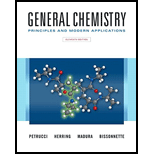
(a)
Interpretation:
The structure of the product obtained by the reaction between propene and hydrogen gas in the presence of metal catalyst should be determined.
Concept introduction:
The addition on the alkene is the electrophilic addition reaction. In this reaction, electrophile reacts with carbon-carbon double of the alkene which results in the formation of
The hydrogenation of
A nucleophile is the Lewis base that donates an electron pair to form a covalent bond with the electrophile.
An electrophile is the Lewis acid that accepts the electron to form a bond with the nucleophile.
(b)
Interpretation:
The structure of the product obtained upon heating
Concept introduction:
The preparation of alkene is the type of elimination reaction.
The
The
A nucleophile is the Lewis base that donates an electron pair to form a covalent bond with the electrophile. An electrophile is the Lewis acid that accepts the electron to form a bond with the nucleophile.
The good leaving groups are the weak base. They can be an anion or neutral molecule.
Want to see the full answer?
Check out a sample textbook solution
Chapter 27 Solutions
Generl Chem Looself&mod Mst/et&stdy Crd Pkg, 11/e
- The compound 2,3-dibromo-2-methylhexane is formed by addition of Br2 to an alkene. Identify the alkene, and write an equation for this reaction.arrow_forwardSeveral diamines are building blocks for the synthesis of pharmaceuticals and agro-chemicals. Show how both 1,3-propanediamine and 1,4-butanediamine can be prepared from acrylonitrile.arrow_forwardLipoic acid is required by many microorganisms for proper growth. As a disulfide, it functions in the living system by catalyzing certain oxidation reactions and is reduced in the process. Write the structure of the reduction product.arrow_forward
- There are three isomers of dichlorobenzene, one of which has now replaced naphthalene as the main constituent of mothballs. a. Identify the ortho, the meta, and the para isomers of dichlorobenzene. b. Predict the number of isomers for trichlorobenzene. c. It turns out that the presence of one chlorine atom on a benzene ring will cause the next substituent to add ortho or para to the first chlorine atom on the benzene ring. What does this tell you about the synthesis of m-dichlorobenzene? d. Which of the isomers of trichlorobenzene will be the hardest to prepare?arrow_forwardWrite a complete chemical equation showing reactants, products, and catalysts needed(if any) for the following reaction and (2) Draw and name the organic compound found inevery reaction.(Use condensed structural formula) (A) Reaction of cis-3,3-Dimethyl-4-propylocta-1,5-diene with two mole of HBr(B) Reaction of trans-1-Bromo-3-chlorocyclopentane with potassium hydroxide(C) Formation of Gilman reagent using isopropyl bromidearrow_forwardCHEMISTRY AND ENVIRONMENTAL POLLUTION Explain how Hg2+ ion is transformed into methylmercury anddimethylmercury in the aquatic environment.arrow_forward
- Thank you Using structural formula, draw the following reactions indicating the products formed. a. Hydrogenation of 2-hexene with nickel catalyst and heat b. 2-Pentene and bromine (Br2)arrow_forward7. How many carbon atoms are there in 2,5-diethyl-7-methylbicyclo[2.2.1]heptane? 8. R-MgX and CO2 are reacted to form isobutyric acid. What is R? Use IUPAC nomenclature of the substituent. 9. From which cycloalkene can heptanoic acid be formed from through oxidative cleavage? Use IUPAC name. 10. The catalytic hydrogenation of a benzene will result to this cycloalkanearrow_forwardWhich combination of reagents would you use to prepare chlorobenzene (C6H5Cl) from benzene (C6H6)? Select one: a. HCl and HNO3 b. HCl and H2SO4 c. Cl2 and FeCl3 d. HClO and FeCl3 e. Cl2 and FeBr3arrow_forward
- Write the equations for the reactions of p-dichlorobenzene a. Hydrogenation of p-dichlorobenzene b. Nitration of p-dichlorobenzene c. sulfonation of p-dichlorobenzene d. chlorination of p-dichlorobenzenearrow_forwardHydrocarbon A, C8H12 absorbs 3 equiv. of hydrogen to give B, C8H18 when hydrogenated over a Pd/C catalyst. Treatment of A with aqueous H2SO4 and Hg(II) gives a single ketone, C. Oxidation of A with KMnO4 gives CO2 and the two carboxylic acids D & E shown below. What would be a structure for A?arrow_forwardI need help to draw the structure of compound XYNZ for compounds XNZ different substitutes are possible however I need to use hydrogen and the substitutionarrow_forward
 Introductory Chemistry: A FoundationChemistryISBN:9781337399425Author:Steven S. Zumdahl, Donald J. DeCostePublisher:Cengage Learning
Introductory Chemistry: A FoundationChemistryISBN:9781337399425Author:Steven S. Zumdahl, Donald J. DeCostePublisher:Cengage Learning ChemistryChemistryISBN:9781305957404Author:Steven S. Zumdahl, Susan A. Zumdahl, Donald J. DeCostePublisher:Cengage Learning
ChemistryChemistryISBN:9781305957404Author:Steven S. Zumdahl, Susan A. Zumdahl, Donald J. DeCostePublisher:Cengage Learning Chemistry: An Atoms First ApproachChemistryISBN:9781305079243Author:Steven S. Zumdahl, Susan A. ZumdahlPublisher:Cengage Learning
Chemistry: An Atoms First ApproachChemistryISBN:9781305079243Author:Steven S. Zumdahl, Susan A. ZumdahlPublisher:Cengage Learning
 Chemistry for Today: General, Organic, and Bioche...ChemistryISBN:9781305960060Author:Spencer L. Seager, Michael R. Slabaugh, Maren S. HansenPublisher:Cengage Learning
Chemistry for Today: General, Organic, and Bioche...ChemistryISBN:9781305960060Author:Spencer L. Seager, Michael R. Slabaugh, Maren S. HansenPublisher:Cengage Learning General Chemistry - Standalone book (MindTap Cour...ChemistryISBN:9781305580343Author:Steven D. Gammon, Ebbing, Darrell Ebbing, Steven D., Darrell; Gammon, Darrell Ebbing; Steven D. Gammon, Darrell D.; Gammon, Ebbing; Steven D. Gammon; DarrellPublisher:Cengage Learning
General Chemistry - Standalone book (MindTap Cour...ChemistryISBN:9781305580343Author:Steven D. Gammon, Ebbing, Darrell Ebbing, Steven D., Darrell; Gammon, Darrell Ebbing; Steven D. Gammon, Darrell D.; Gammon, Ebbing; Steven D. Gammon; DarrellPublisher:Cengage Learning





